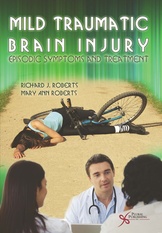Publication
Mild Traumatic Brain Injury
Episodic Symptoms and Treatment
- Details:
- 337 pages, Illustrated (B/W), Softcover, 6 x 9"
- ISBN13:
- 978-1-59756-423-6
- Release Date:
- 11/01/2010
Overview
Mild Traumatic Brain Injury proposes that there is a diagnosable and treatable sub-type of Persistent Post-Concussive Syndrome (PPCS) following mild Traumatic Brain Injury (TBI). This sub-type of PPCS is characterized by: (a) multiple intermittent (or partial seizure-like) symptoms in the absence of a conventional epileptic syndrome; (b) untriggered, ego-dystonic mood-swings in the absence of clear environmental precipitants; (c) memory lapses and brief gap of lost time; and a high prior probability of responding well to treatment with anti-convulsant mood-stabilizers, such as valproic acid (Depakote, Divalproex) and carbamazepine (Tegretol). Both pediatric and adults patients may suffer from this loosely-defined syndrome and may go untreated for months or even years following one or more instances of mild TBI.
The authors and contributors, from diverse professional backgroundsincluding Adult Neuropsychology, Child Neuropsychology, Sports Medicine, and Neuropsychiatrypresent a valuable, expert insight into the needs and methods of treatment for this large and often underserved population. Clearly written, practical, and requiring little knowledge of brain structure and function, Mild Traumatic Brain Injury provides all involved in client care with the tools they need to ensure good outcomes. Of particular value will be the near-unique coverage of the the mechanisms underlying blast-induced neuro-trauma, a subject of great concern to military personnel, care-providers, and their families.
The acronym MIND stands for Multi-symptomatic Intermittent Neurobehavioral Dysfunction
- Chapter One: Brain injury due to Blunt-Force Trauma
- Chapter Two: Illustrative Case History of a Patient with MIND
- Chapter Three: Navigating the Healthcare System following Mild TBI
- Chapter Four: Evidence for the Existence of MIND-like Neuropsychiatric Patients
- Chapter Five: Living with Untreated Symptoms of MIND
- Chapter Six: Reviewing the Evidence for Treatment Efficacy
- Chapter Seven: Mood-Stabilizing Medications with Anticonvulsant Properties
- Chapter Eight: Blast Trauma: an Ominous New Risk Factor for MIND
- Chapter Nine: Blast Trauma II: Symptomatic Treatment in the Short-Run
- Chapter Ten: Using Effective Coping Behaviors
- Chapter Eleven: MIND in Pediatric Patients
- Chapter Twelve: Unanswered Questions and Issues Requiring Further Study
- Chapter Thirteen: A Summing Up
- Appendices
- Technical Appendix A: The Iowa Interview (13,337)
- Technical Appendix B: Making the Diagnosis of MIND in Adults
- Technical Appendix C: Making the Diagnosis of MIND in Children and Adolescents
- Technical Appendix D: Conservative Clinical Neuropsychologists and Mild TBI: Is Anyone Ever Hurt?
About The Authors
Richard J. Roberts, PhD, is an Adjunct Associate Professor at the University of Iowa.
Mary Ann Roberts, PhD, University of Iowa
Related Titles
Neurogenic Communication Disorders
Barbara B. Shadden, Fran Hagstrom, Patricia R. Koski
257 pages, Illustrated (B/W), Softcover, 7 x 10"
Aphasia Rehabilitation: The Impairment and Its Consequences
Nadine Martin, Ph.D., Cynthia K. Thompson, Ph.D., Linda Worrall, Ph.D.
277 pages, Illustrated (B/W), Softcover, 6 x 9"
Brain-Based Communication Disorders
Leonard L. LaPointe, Bruce E. Murdoch, Julie A. G. Stierwalt
265 pages, Color Illustrations (4 Color), Hardcover, 7 x 10"
Aphasia Couples Therapy (ACT) Workbook
132 pages, Illustrated (B/W), Softcover, 8.5 x 11"
Head Injury Recovery in Real Life
Larry E. Schutz, Michael E. Schutz
349 pages, Illustrated (B/W), Softcover, 6 x 9"














